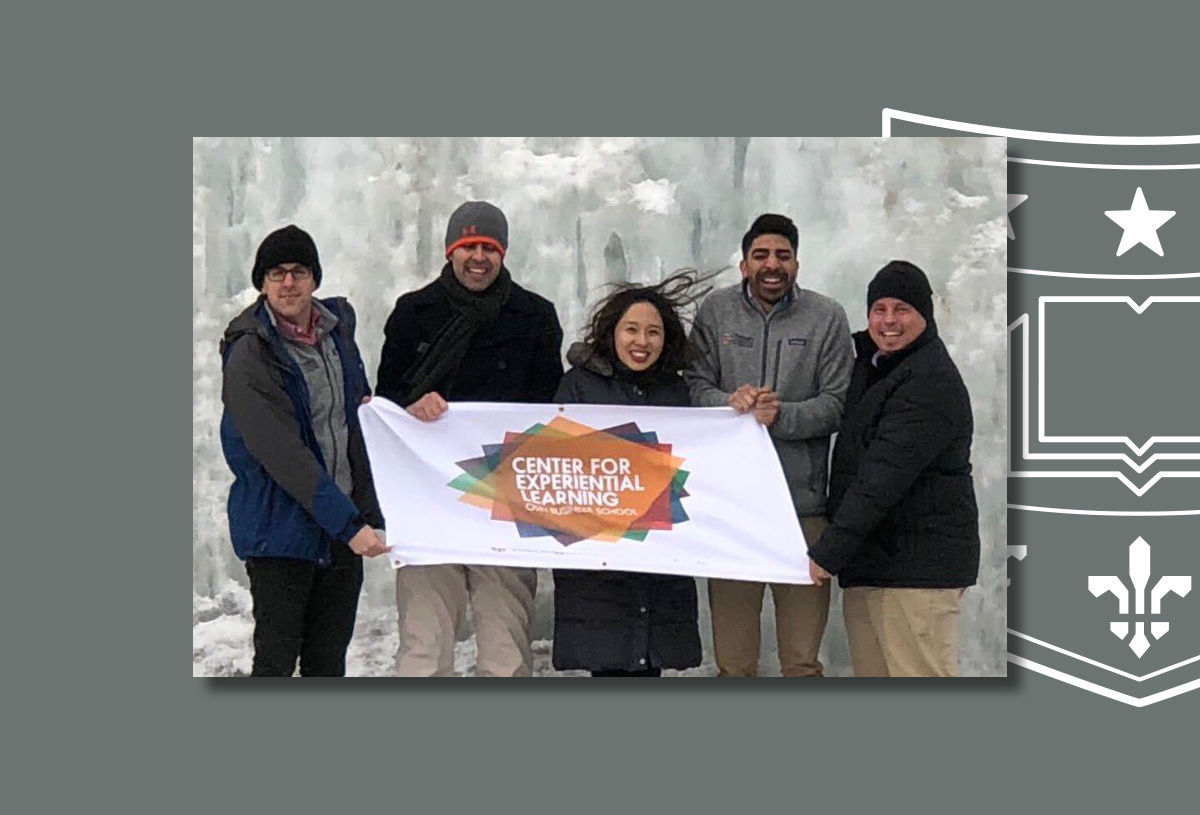Alaska trip caps practicum project for Olin CEL team
- August 1, 2018
- By Guest Author
- 5 minute read

Jeff Brown, MBA 2019, wrote this on behalf of his practicum team from the Center for Experiential Learning. MBA 2019 team members included Jeff Brown, Abdul Rehman Azmat, Grace Lee, Ricardo Marrujo Mexia, and Samuel Roth. The project advisor was Rich Ryffel.
Our client was Doyon Limited. Doyon is an Alaskan Native Corporation (ANC) and the largest private land owner in the United States. At the beginning of the project, we knew little about ANCs or about the Alaska Native Claims Settlement Act that led to their creation.
What we soon discovered, however, was that Doyon has a responsibility to protect Native Alaskan land and resources and to help its shareholders flourish. The part we were to play in helping Doyon fulfill this mission involved strategic planning as Doyon seeks to diversify beyond its core upstream oil and gas ventures.
Structuring the problem
Our first task was to bring structure to ambiguity—to bring ourselves down from 30,000 feet to ground level. This proved to be more difficult than expected. The complexity of the project put us in danger of venturing down numerous rabbit holes and getting lost in the minutia of the industries we were tasked with analyzing. However, our ability to clearly define the project via a statement of work hammered out together with the client helped us to create a project framework and stay on track.
Interacting with the client
In our first week on the project, we had the pleasure of meeting Doyon executives in person. Throughout the day, we interacted with the client professionally and—just as importantly—personally. too. This time spent together allowed us to better understand Doyon’s business and helped build a rapport that was useful during subsequent meetings. We became more confident that we could ask difficult questions, and at the same time, the client gave honest feedback on our work. In the end, because of the trust we built, we delivered a better final product and more value for Doyon.
Housekeeping and administration
Sometimes the little things can have major implications in a client relationship. After our first virtual meeting, our advisor, Rich Ryffel, gave us a piece of advice that we will use moving forward: “Make sure to keep meetings within the scheduled time or the value of your time will be diminished in the client’s eyes.”
Rich explained that not only should you respect the client’s time but that the client should respect yours, too. Mutual respect can keep both sides from making unreasonable asks and help maintain a productive working relationship.
Getting to know the local culture
Phase 2 of the project took us to Alaska, where we visited Doyon’s offices in Fairbanks and Anchorage. We also presented the results of our analysis and recommendations on which industry to make the focal point of phase 3.
The team spent the first two days as tourists, attending cultural events and visiting various attractions. We watched the beginning of the Iditarod, hiked a waterfall trail, and even caught a glimpse of Denali. When the meetings started, we were given a tour of Doyon’s in-house museum of native Alaskan artifacts and had lunch featuring dried salmon that is apparently such a delicacy that buying and selling it is regulated by the federal government. These experiences taught us a lot about native Alaskan culture and drove home the importance of Doyon’s core values.
Understanding the client’s businesses
Through meetings with various subsidiaries, we developed a better understanding of those businesses’ relationship with the holding company. We learned about utility joint ventures, oil exploration, pipeline building, oil and gas engineering services, and government IT outsourcing.
The meetings illustrated the real-world implications of findings from Frost and Sullivan, Ibis, Bloomberg, and others. Each night, after a long day of meetings and dinner, we rushed back to the hotel and worked well after midnight to incorporate what we had learned into the presentation we were preparing for senior leadership.
Adapting the message
Finally, the team met with the CEO, COO, and CFO to present our mid-project recommendations. Each executive brought a different perspective, and with that perspective, a different level of interest in or resistance to our recommendations. The discussion was not always easy, but the reactions we received taught us that, when presenting to executives, we need to consider all the vested interests in the room so that recommendations may be as acceptable, practical, and actionable as possible
Pushing till the end
Our final presentation went off with a hitch, and our team leader, Jeff Brown, was even invited to present our findings to the Doyon board of directors at their annual meeting. The feedback from Doyon was positive, and we wrapped things up with confidence that Doyon could integrate our recommendations into its long-term strategic planning process. While we learned a lot about business throughout this process, the best part of the experience was the time spent with the team and the client.
Having fun with the team
As MBA classmates, we already knew each other to varying degrees, but sharing this experience brought us closer and created moments that we’ll remember long after we’ve forgotten the actual project. One such memory was the birthday party that we threw for Grace while in the middle of putting the final touches on our executive summaries.
We surprised Grace with a card and cupcakes and sang happy birthday in the meeting room. It was just one moment during one meeting, but the experience was indicative of the good times the team shared together and of why we are much closer now than at the beginning despite the intensity of the experience.
Working with the client
Working with the client has taught us how to lead meetings with confidence, how to communicate more clearly, and how to read the client for clues about where they are taking the conversation. All these skills came to bear during our final presentation, which was done remotely via WebEx.
In a video conference, reading nonverbal cues can be very difficult, and the meeting flow can easily break down. By the time we delivered our final presentation, we had already completed five previous video conferences. As a result, we were familiar with how to manage the pauses, how to read the client’s questions, and how to reply in a way that moved the conversation forward.
These experiences will be invaluable in our future career and made us look back on our final presentation with so much pride about the work we’d done.
Pictured at top: Team members Jeff Brown, Abdul Rehman Azmat, Grace Lee, Ricardo Marrujo Mexia, and Samuel Roth, all MBA 2019.
Media inquiries
For assistance with media inquiries and to find faculty experts, please contact Washington University Marketing & Communications.
Monday–Friday, 8:30 to 5 p.m.
Sara Savat
Senior News Director, Business and Social Sciences
